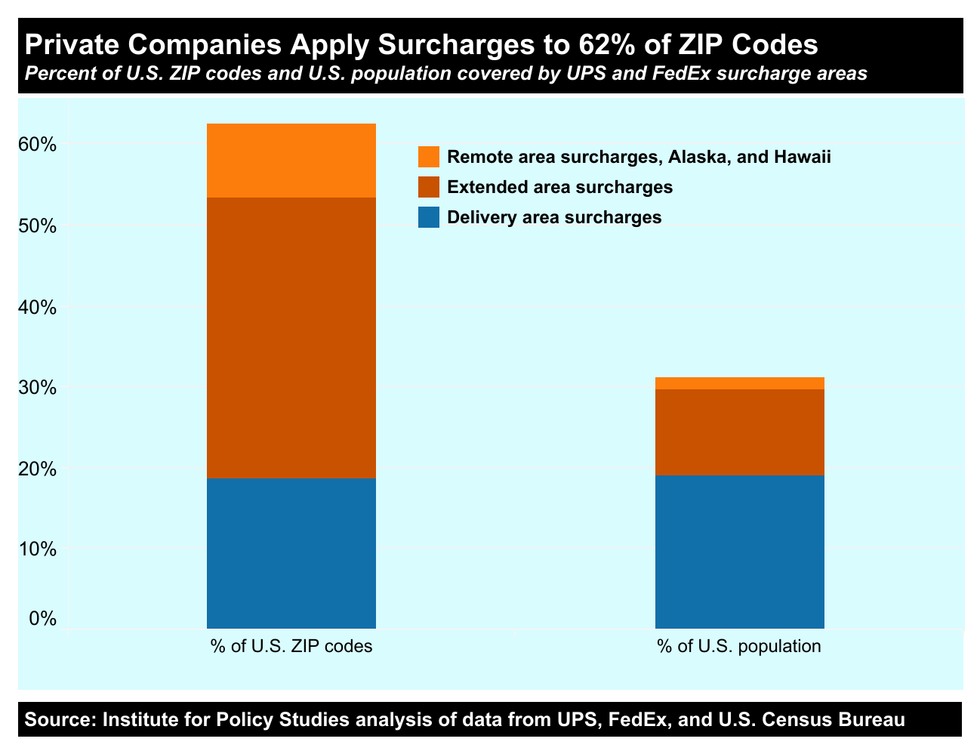- U.S. President Donald Trump and Elon Musk have expressed an interest in selling off the U.S. Postal Service to for-profit corporations. Even piecemeal privatization of this public agency would have wide-ranging effects on postal customers, employees, businesses, and our broader economy. One nearly certain result: a dramatic increase in package delivery prices.
Unlike the for-profit carriers, the Postal Service has a universal service obligation to provide affordable deliveries to all Americans, regardless of where they live or work. Currently, USPS parcel rates are about 25% to 60% below FedEx and UPS prices.
Would we want for-profit corporations handling our ballots?
Without competition from this public service, for-profit firms would jack up delivery fees on as many customers as possible. Who would be hit hardest? Most likely those who live or work in ZIP codes where private carriers already impose surcharges because deliveries to these addresses are less profitable.
A new Institute for Policy Studies report finds that UPS and FedEx area surcharges now apply to retail customers sending parcels using their own packaging to addresses in ZIP codes where 102 million Americans live. Not surprisingly, these include addresses in Hawaii, Alaska, and rural and remote areas. But they also cover many small towns and neighborhoods just outside major cities.

UPS and FedEx charge around $43 extra for shipments to Alaska and about $15 extra for deliveries to Hawaii and remote areas where nearly 4 million Americans live. The private carriers slap “extended area surcharges” of $8.30 on home deliveries in rural ZIP codes with a combined population of 35 million. Residential delivery surcharges run a little over $6 in suburban and small-town ZIP codes where 19 million people live.
Unlike the public Postal Service, the private carriers also impose extra charges for Saturday delivery, for fuel (based on distance), for package pickup, and for residential delivery. These charges reflect the higher costs for companies that, unlike USPS, aren’t already visiting every address six days a week.
Today’s higher FedEx and UPS delivery rates are just a taste of what would come if the Trump administration succeeds in privatizing USPS. In fact, Wells Fargo recently published a postal privatization plan that recommends hiking USPS parcel delivery rates by 30% to 140%. Their aim: to fatten up the hog before selling off this lucrative part of the postal business. Private carriers could also flat out refuse to deliver to far-flung addresses.
On top of higher delivery costs, rural communities would suffer the most from other impacts of a for-profit model. For instance, they would likely face the shuttering of many post offices and the related loss of postal jobs that pay decent wages with benefits.
Rural residents also rely heavily on USPS to deliver prescriptions, since many small-town pharmacies have shut down. The Postal Service also handles mail order prescriptions for military veterans, more than a quarter of whom live in rural areas.
During the 2024 general election, the Postal Service delivered more than 99 million ballots to or from voters. Rural voters rely particularly heavily on the mail-in option because physical polling sites are often long distances from their homes. Nationwide, half of rural county polling sites serve an area greater than 62 square miles, compared to just 2 square miles for urban sites. Would we want for-profit corporations handling our ballots?
Over its 250-year history, our public Postal Service has continually reinvented itself in response to changes in technology and the evolving needs of our society. Rather than selling this public treasure off to the highest bidder, we should explore opportunities for strengthening the Postal Service to deliver even better services in the 21st century.
In addition to the growing package delivery market, there are many opportunities for generating new revenue. For example, USPS could provide additional financial services, such as low-fee ATMs and check cashing. It could work with state and local governments to gather data on public safety and environmental risks through monitors on delivery vehicles. It could follow the models of some foreign postal services by providing check-in services for elderly and disabled residents.
With its extensive and valuable human resources and infrastructure, USPS has a strong foundation on which to continue providing a vital public service for all Americans for generations to come.

